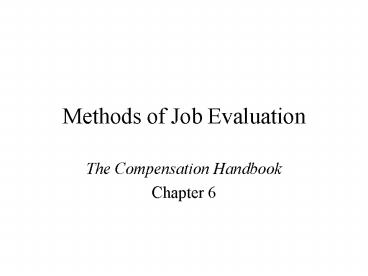Methods of Job Evaluation - PowerPoint PPT Presentation
1 / 15
Title:
Methods of Job Evaluation
Description:
We'll look at the four major methods used in job evaluation ... 'Alternation' method ranks 'highest' then 'lowest,' then next 'highest, ... from Otis and ... – PowerPoint PPT presentation
Number of Views:1800
Avg rating:3.0/5.0
Title: Methods of Job Evaluation
1
Methods of Job Evaluation
- The Compensation Handbook
- Chapter 6
2
In this session.
- Well look at the four major methods used in job
evaluation and the advantages/disadvantages of
each - Job Ranking Method
- Job Classification Method
- Point Method
- Factor Comparison Method
3
Job Evaluation Methods
4
Ranking Method
- Advantages
- Simple
- Alternation method ranks highest then
lowest, then next highest, then next lowest - Paired comparisons method picks highest out of
each pair - Fast
- Most commonly used
- Disadvantages
- Comparisons can be problematic depending on
number and complexity of jobs - May appear arbitrary to employees
- Can be legally challenged
- Unreliable
5
Classification Method
- Advantages
- Uses job families/groups instead of individual
jobs - May produce same results as Point Method, but is
less costly
- Disadvantages
- Not useful when jobs are very different from each
other - May be confusing to employees about why jobs are
included in a class
6
Factor Comparison Method
- Advantages
- Customized to the organization
- Relatively easy to use once its set up
- Results in ranking of jobs and a specific dollar
value for each job, based on allocating part of
the jobs total wage to each factor
- Disadvantages
- Using dollar values may bias evaluators by
assigning more money to a factor than a job is
worth - Hard to set up
- Not easily explained to employees
- Every time wage rates change, the schedule
becomes obsolete
7
Point Method
- Advantages
- Highly stable over time
- Perceived as valid by users and employees
- Likely to be reliable among committee that
assesses the jobs - Provides good data to prepare a response to an
appeal
- Disadvantages
- Time, money, and effort required to set up
- Relies heavily on key (benchmark) jobs, so if key
jobs and correct pay rates dont exist, the point
method may not be valid
8
Factor Degrees and Point Systems
9
What is a Degree Level?
- It is a scale that reflects differing quantity or
quality of the factor - It is used to differentiate jobs on the factor
- It is a definition that is clear and unambiguous
- It contains explicit language that spells out the
behaviors, skills, or performance expectations
for that factor at different levels of the factor
10
How Do You Develop Degrees?from Otis and
Leukarts (1948) Rules
- Degrees should be selected so that each job falls
at only one level. Note you can include some
degrees that do not apply to the current jobs if
you feel there is too much of a jump between
levels. Another reason to create "empty" levels
is if you think new jobs will be created that
will require that level in the factor. The
number of degrees selected should be no more than
are needed to differentiate adequately and fairly
between all the jobs being rated. - Each degree should be clearly defined in terms
the workers can understand. - Avoid the use of ambiguous terms, e.g., strong
skills, excellent. - Definitions of degrees should be written in
objective terms. - In writing degree definitions, use examples as
much as possible.
11
How Do You Assign Point Values to the Entire
System?
- The maximum number of points assigned is a fairly
arbitrary judgment (500-3000 is common) - The number must be large enough to allow
sufficient differentiation among the jobs to be
evaluated. - If there is a very wide spread between the
current wages of the highest paid job and the
lowest paid job, the maximum number of points
will need to be higher - If you choose more than one pay system, the
number of points or the actual factors themselves
do not have to be the same in each one. - SUGGESTION FOR YOUR PROJECT Have no fewer than
1000 points and no more than 2000.
12
How Do You Assign Point Values to the Degree
Levels?
- First, determine the number of points for each
main factor (e.g., 2000 total points for the
system would result in 200 points for a factor
weighted at 10). Then use - The straight-line method, which simply takes the
maximum points for a given factor and divides it
by the number of degrees. Note this method
assumes that the degrees should be viewed as
equidistant from each other
13
(No Transcript)
14
How Do You Assign Point Values to the Degree
Levels?
- Or the accelerating method, where differences in
degrees are seen as greater as you move up in
that factor, and so the point differences reflect
that jump, e.g., 27, 80, 160, 267, 400 - Or the decelerating method, where differences in
degrees are seen as smaller as you move up in
that factor, and so the point differences reflect
it, e.g., 133, 240, 320, 373, 400 - Rememberthe highest level of a factor is always
assigned the full number of points allocated to
that factor, and the lowest level of a factor has
to have some points assigned to it, i.e., 0
points is not permitted!
15
Whats Next?
- In the next class session, well practice
evaluating the ten jobs using the Point Method - Bring with you to class (10) copies of the Job
Evaluation Form on our website, and the ten Job
Analyses with the Factors and Weights you
generated for them































